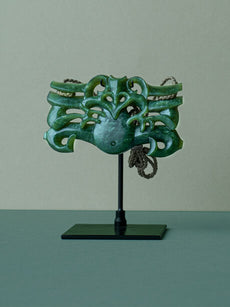Your cart is empty
Keep ShoppingExploring Māori surface designs and patterns
Toi, or Māori art, evolves around four primary art forms: raranga (weaving), whakairo (carving), tā moko (tattooing) and peitatanga (painting).
Across these art forms, distinguishable surface designs and patterns are frequently added to artistic works and play an important role in conveying the kōrero (story) and kaupapa (purpose) of a piece of art.
Carved objects made from bone, stone, or wood, have surface designs added by cutting grooves, notches, and etching. Whereas in weaving, patterns are added by overlapping and underlapping dyed or naturally coloured materials. In traditional tā moko, a design was added to the body by using knives and chisels made from shark teeth and sharpened bone dipped in natural inks.
There are many interpretations of each surface design and pattern, and although they are perspectives of the same ideology, they have been customised to accommodate different tribal areas and identities.

Many of our artists look to customary surface designs and patterns used within different Māori art forms to connect with mātauranga (Māori knowledge) and to inform and inspire their contemporary pounamu designs.
Here we take a look at the meanings behind some of the most recognisable Māori surface designs and patterns and how our artists incorporate and adapt them in their work.
Unaunahi
Unaunahi, is a curvilinear design with crescent shaped incisions being set about an equal distance from one another. Thought to represent fish scales, this design symbolises the close association Maori have with the ocean as both a food source and as a link to their spiritual homeland of Hawaiki. Unaunahi design is often found in wood carvings motifs.


Pākati Haehae
Pākati Haehae is a surface design with deep gouges, with pākati meaning to incise and haehae to lacerate. It is often found on tukutuku panels and in tāniko weaving. This design has several symbolic meanings, one being the emotional and grieving pain felt when a loved one passes, and another representing animal entities such as niho taniwha (teeth of a taniwha, a supernatural being) or niho kuri (teeth or a dog). Over time, different tribal areas have developed their own stylisations of this pākati haehae.


Harakeke Weaving
Harakeke (New Zealand flax) was prized by Māori and traditionally used for a multitude of purposes in everyday domestic life. The art of raranga (weaving) was essential, and harakeke would be weaved to make clothing garments such as the korowai (cloaks), kete (baskets) for carrying and preserving kai (food), whāriki (mats) to cover the floors of whare (houses), hīnaki (traps) for snaring eels, and for decorative panels on the walls of meeting houses. The quality of the weaving was determined by the items intended use and some of the finer weaving patterns included multiple coloured elements obtained by dying strips of harakeke.


Pūngāwerewere
Pūngāwerewere is the Māori word for spider, and this surface design with its triangular incisions is thought to tell the story of Tāwhaki’s ascent to the heavens of the overworlds climbing on a thread of spider’s web. While climbing, legend tells that Tāwhaki encountered a pūkeko (swamp hen) and pinched it on the bill causing it to bleed. Today the bird wears the distinctive red colouration on its bill and has a shielded forehead as testament to the encounter.


Raperape
This interlocking spiral design shows the same curvilinear line entering and exiting the spiral, paying reference to the movement of life and evolution of death. Some tribal areas also associate the raperape with the pito (navel/umbilical cord). This design is often found adorning the body in the art of tā moko.


Kowhaiwhai
Kowhaiwhai is a curvilinear surface design with many expressive variations, typically depicted in whakairo, tā moko and peitatanga. As a fluid design, artists can manipulate and accommodate kowhaiwhai patterns in many areas of their work, hence the diverse application of this design. The koru (coiled element of the design) is thought to represent the unfurling frond of the native New Zealand silver fern and is symbolic of the cycle of birth, life and death, using the analogy of the spore developing into a coiled bud and then unfolding into a mature fern leaf.

-

Mythological creatures in Māori culture.
Māori culture is rich in pūrākau (legends), and within these legends, mythological, supernatural, and magical creatures are featured prominently, often acting as kaitiaki (guardians) of people or places worth protecting....
-

The significance of Māori ocean lore and the hei matau
The ocean is deeply rooted in Māori worldview and culture and thought by many as the foundation of all life. Protected by the gods, it is a source of food and...























Follow Us
Stay in the know on new releases, special offers, and more.